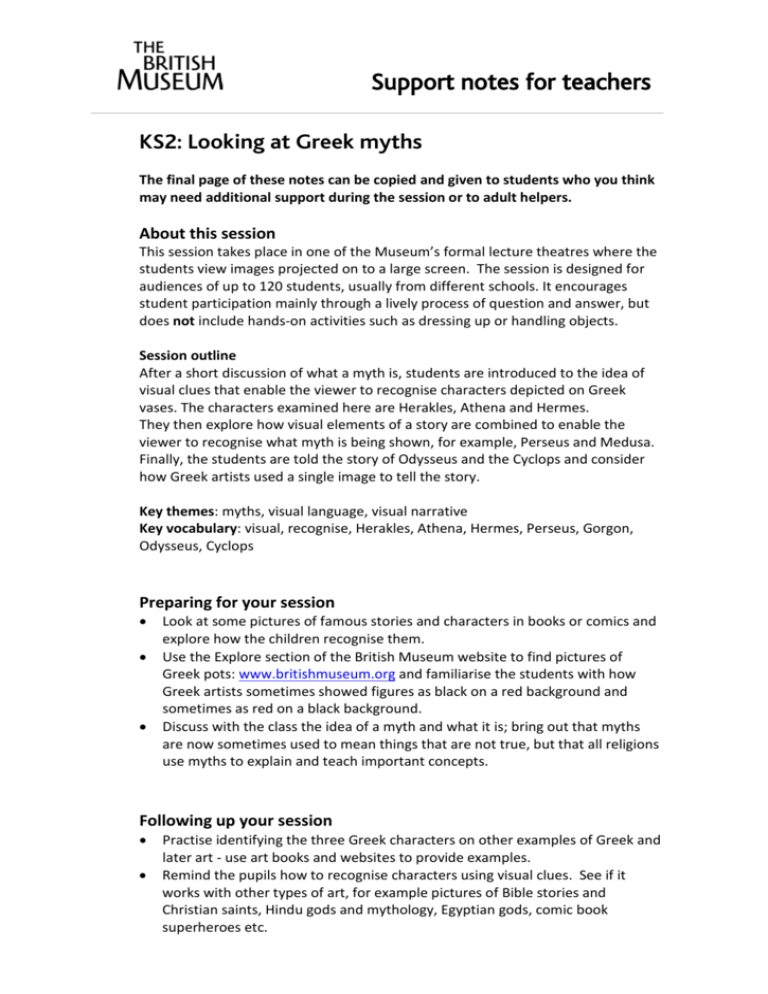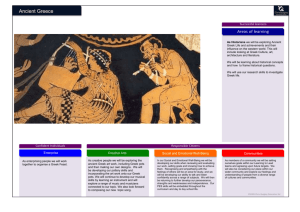KS2: Looking at Greek myths
advertisement

Support notes for teachers KS2: Looking at Greek myths The final page of these notes can be copied and given to students who you think may need additional support during the session or to adult helpers. About this session This session takes place in one of the Museum’s formal lecture theatres where the students view images projected on to a large screen. The session is designed for audiences of up to 120 students, usually from different schools. It encourages student participation mainly through a lively process of question and answer, but does not include hands-on activities such as dressing up or handling objects. Session outline After a short discussion of what a myth is, students are introduced to the idea of visual clues that enable the viewer to recognise characters depicted on Greek vases. The characters examined here are Herakles, Athena and Hermes. They then explore how visual elements of a story are combined to enable the viewer to recognise what myth is being shown, for example, Perseus and Medusa. Finally, the students are told the story of Odysseus and the Cyclops and consider how Greek artists used a single image to tell the story. Key themes: myths, visual language, visual narrative Key vocabulary: visual, recognise, Herakles, Athena, Hermes, Perseus, Gorgon, Odysseus, Cyclops Preparing for your session • • • Look at some pictures of famous stories and characters in books or comics and explore how the children recognise them. Use the Explore section of the British Museum website to find pictures of Greek pots: www.britishmuseum.org and familiarise the students with how Greek artists sometimes showed figures as black on a red background and sometimes as red on a black background. Discuss with the class the idea of a myth and what it is; bring out that myths are now sometimes used to mean things that are not true, but that all religions use myths to explain and teach important concepts. Following up your session • • Practise identifying the three Greek characters on other examples of Greek and later art - use art books and websites to provide examples. Remind the pupils how to recognise characters using visual clues. See if it works with other types of art, for example pictures of Bible stories and Christian saints, Hindu gods and mythology, Egyptian gods, comic book superheroes etc. Support notes for teachers • Compare two pictures of the same story. Discuss what aspects the artist has chosen to focus on. Ask the pupils to think about why the artist might have done this. Show the pupils one picture of a story with which they are familiar perhaps chosen from a book they have read. After discussing it, ask them to do their own picture showing a different interpretation of the story - discuss the different effect. • Explore these two parts of the Museum’s excellent Ancient Greece website on your whiteboard: www.ancientgreece.co.uk/gods/explore/exp_set.html and www.ancientgreece.co.uk/gods/challenge/cha_set.html Galleries with related objects There are numerous Greek pots with scenes from mythology in Rooms 13, 14 and 15. Room 69 has cases dedicated to Herakles, Theseus, the Trojan War and Odysseus Curriculum links KS2 History: ancient Greece KS2 English: traditional stories, storyboarding and sequencing Support notes for teachers KS2: Looking at Greek myths Summary sheet In this session you will learn: • how to recognise characters in pictures of Greek stories • how the ancient Greeks showed their myths in pictures Key words visual - to do with seeing recognise Athena - a Greek goddess gorgon - a Greek monster Cyclops - a Greek giant Perseus - a Greek hero Herakles - a Greek hero Hermes - a Greek god Odysseus - a Greek hero What is a Greek myth? • • • a myth is an old story handed down through time myths often explain things; they were usually important to the people who created them the Greek decorated pottery and buildings with pictures from myths Recognising characters • You will learn how to recognise three characters by using visual clues such as what they carry or wear: Herakles, Athena, Hermes Recognising stories • • • You will then learn how to recognise stories in pictures. You do this by adding together the different characters you recognise and looking at what they are doing. You will see how this works with a picture of Perseus and the gorgon. Telling stories with pictures • • • The ancient Greeks did not use cartoon strips to tell stories. They liked to put things into a picture that belong in different parts of the story. The things remind you of what has happened before and what will happen after the scene you are looking at. You will see how this works with a picture of Odysseus and the Cyclops.









